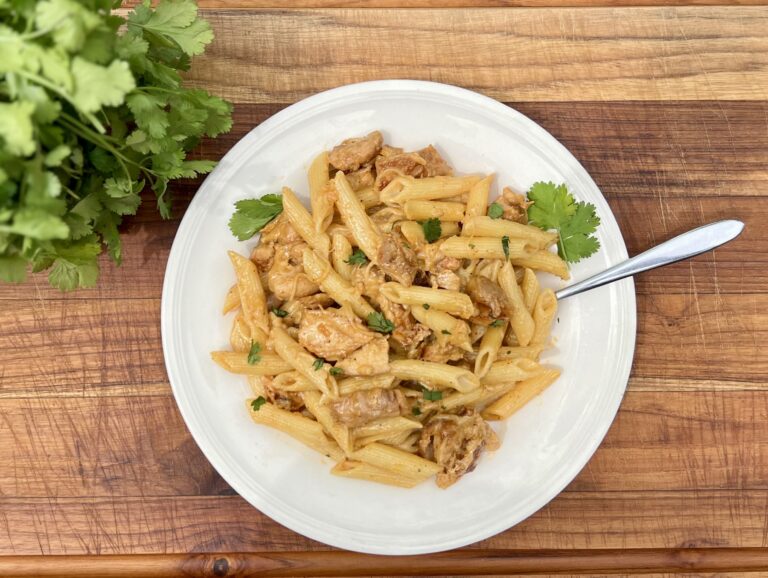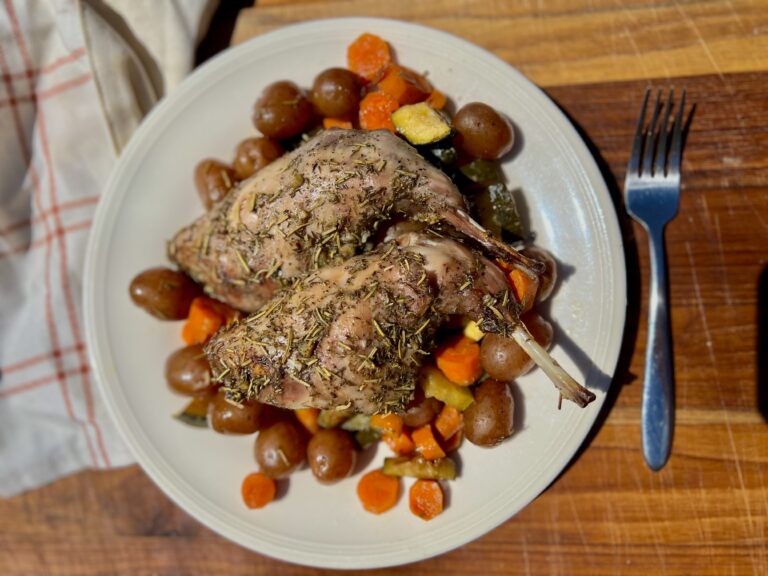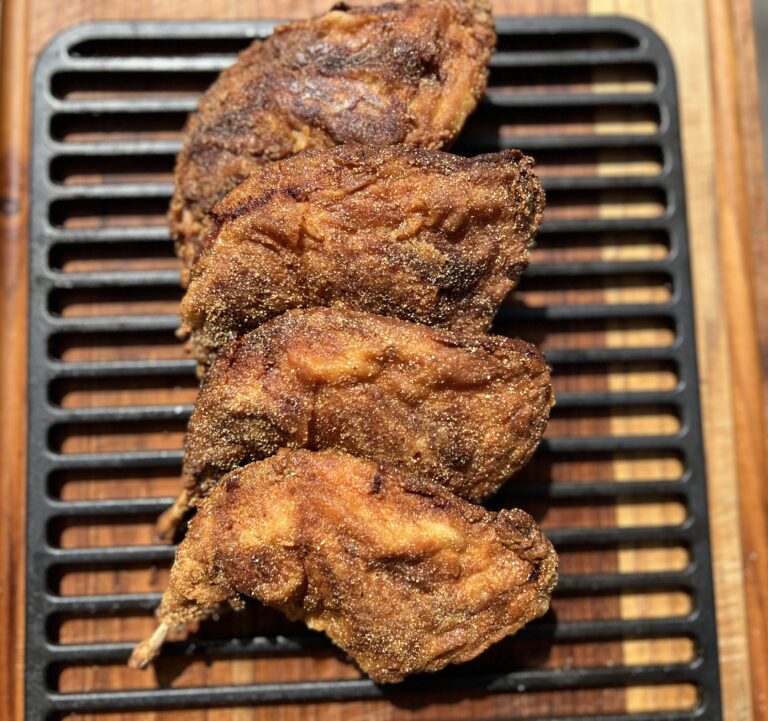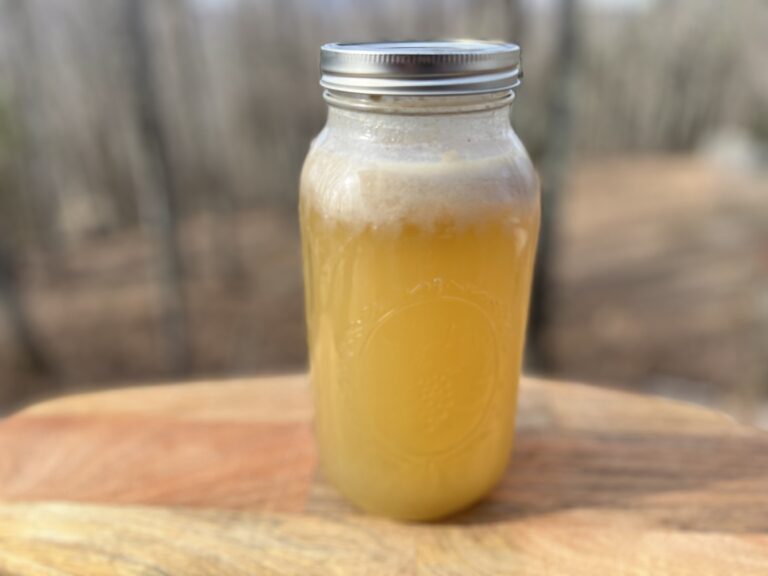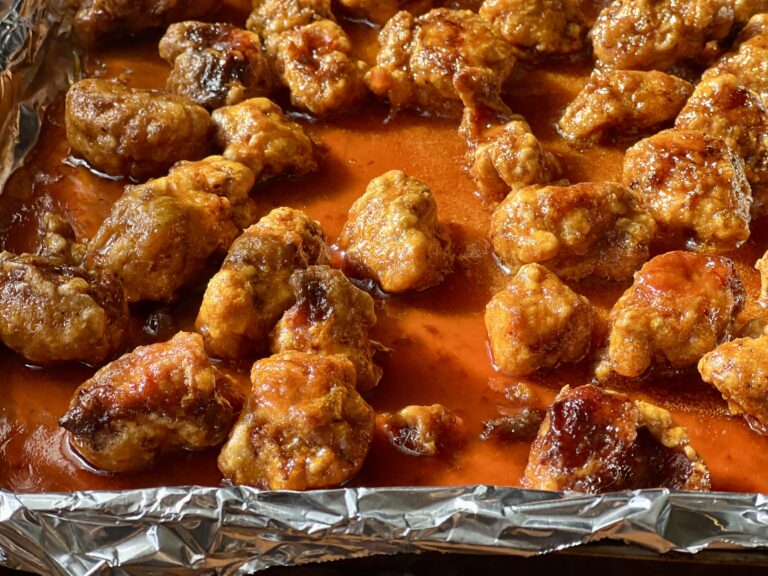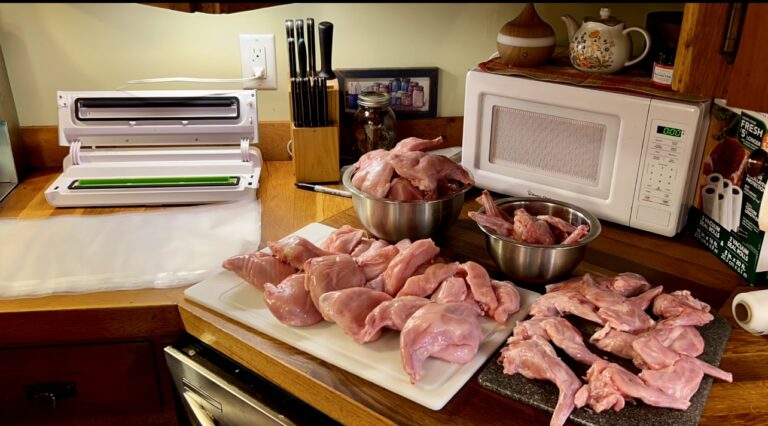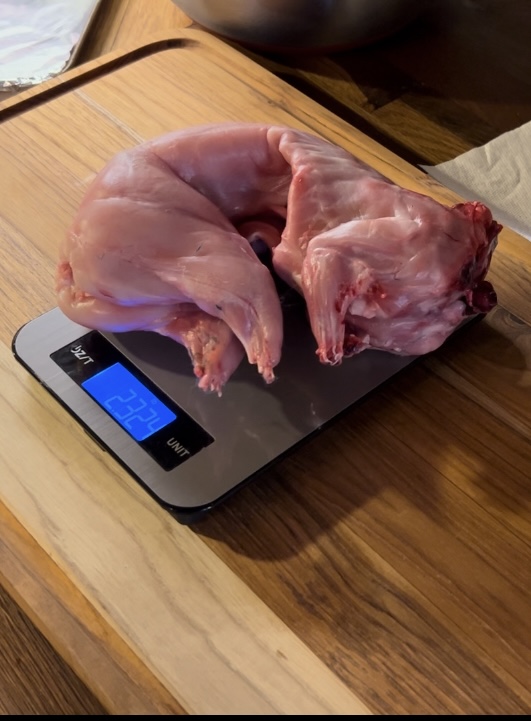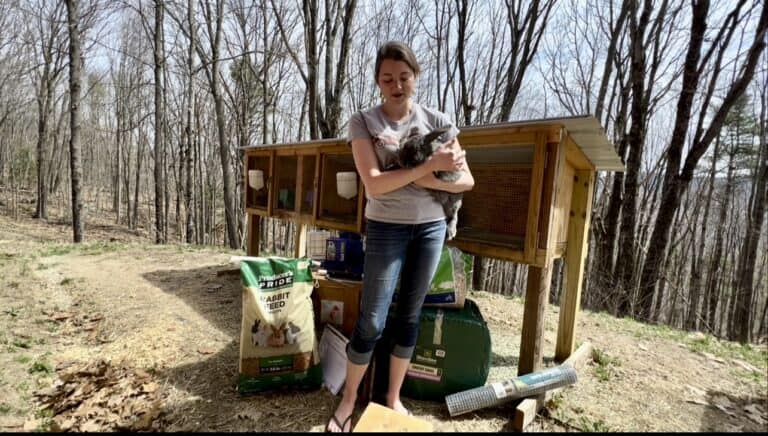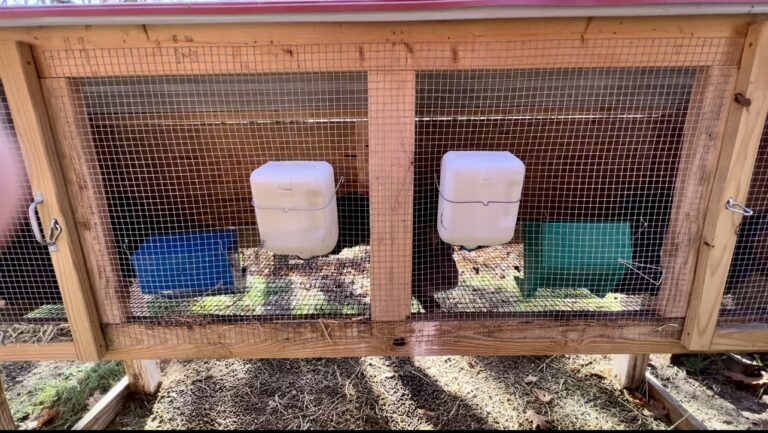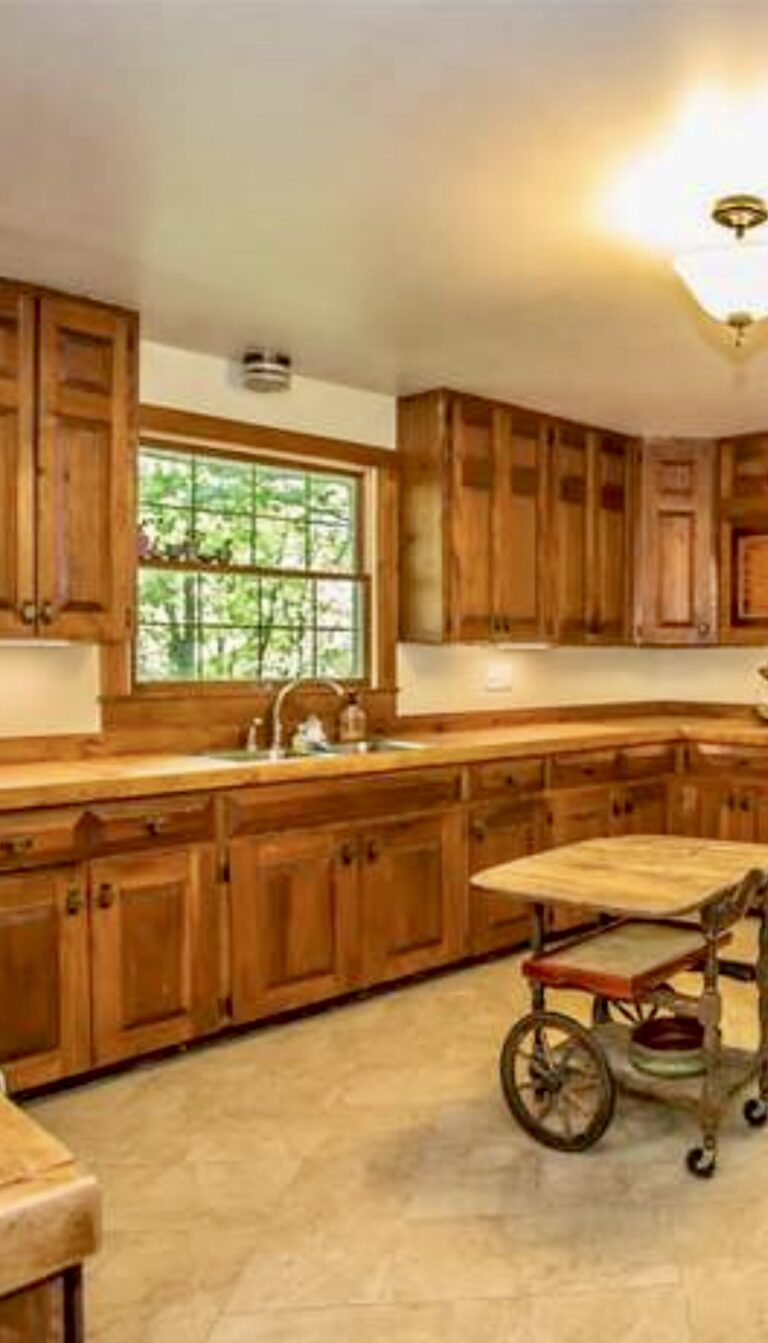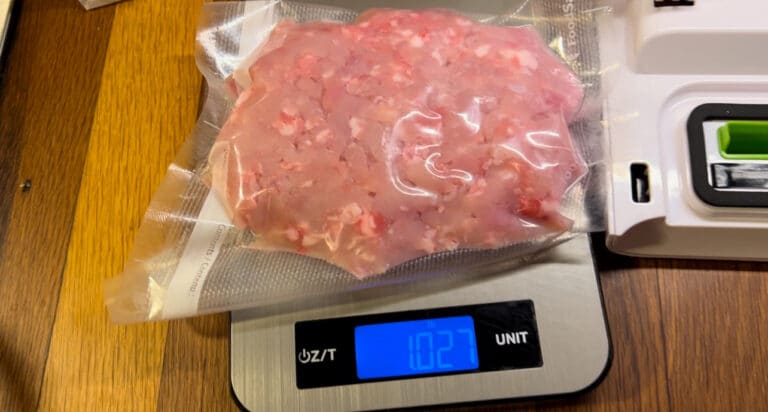Meat Rabbits for Your Homestead: The Ultimate Beginner Guide
Discover everything you need to know about raising meat rabbits—from choosing breeds to building hutches, feeding, breeding, butchering, and more. Perfect for beginners and experienced homesteaders alike.
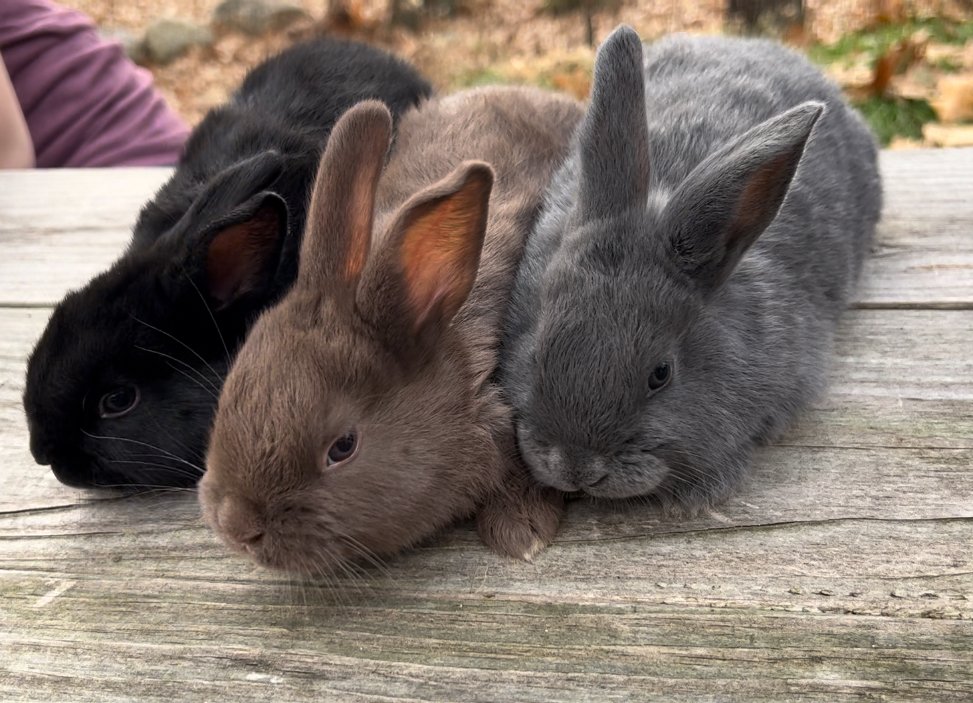
Why Raise Meat Rabbits?
Raising meat rabbits is becoming more popular among homesteaders and small farmers. And for good reason! Here are some of the top reasons why I and others choose to raise meat rabbits:
1. High-Quality Protein Source
Rabbit meat is lean, high in protein, low in fat, and packed with nutrients like B12, iron, and selenium. It’s also a healthy alternative to store-bought meats that is easy to raise, especially for those avoiding hormones and antibiotics commonly found in commercial meats.
I just recently made Firecracker Rabbit the other day and my family loved it! Some of our other favorites are Rabbit Shepherds Pie and Stove Top Ranch Rabbit.
2. Cost-Effective
Rabbits are inexpensive to raise. They don’t require large amounts of land, eat relatively little, and reproduce quickly. You can produce a good amount of meat in a small space with minimal input compared to other livestock.
On my YouTube Channel, The Stone Hearth Farmhouse, I go over my real actual cost to raise meat rabbits! I give a honest review and a complete yearly cost break down. This was the first time I actually documented and reviewed a yearly cost analysis for raising my meat rabbits.
There was definitely room for improvement with the cost of raising my rabbit meat. Also keeping in mind that I raise a Heritage Breed rabbit, which could have lower meat production as compared to other breeds that were specifically breed for meat. I will always be honest with you, and my goal on my channel and blog is to bring you real life experience from the day to day on raising your own meat rabbits.
3. Fast Reproduction & Growth
A single doe can produce 40–50 kits (baby rabbits) per year depending on the breed and average litter size. For example, my Silver Fox does average 8 kits a litter and I breed them 3-4 times a year. So for me that is 32 kits a year from one Doe, and I usually raise 3 does at a time. That’s still a lot of rabbit meat! Most meat breeds reach butcher weight (4–5 lbs live weight) in about 8–12 weeks!
4. Perfect for Small Spaces
Even if you don’t have a lot of land, you can still raise rabbits. They’re quiet, clean, and don’t require pastures like goats or cows. Many people raise rabbits in backyard hutches or colonies.
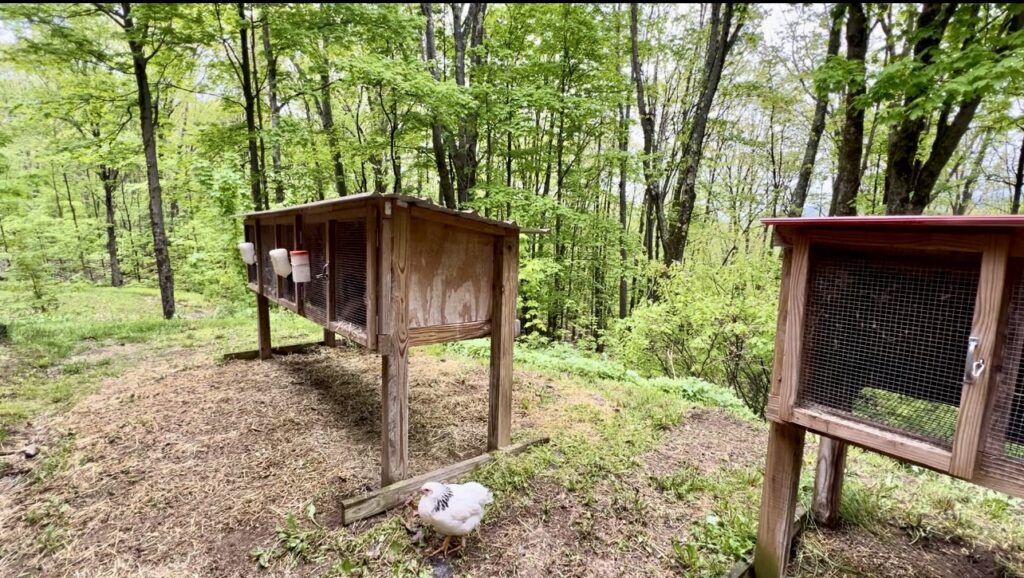
5. Compost!
One of the most overlooked benefits of raising meat rabbits is their manure — and let me tell you, it’s gardening gold.
Unlike chicken or cow manure, rabbit droppings are considered “cold” manure, meaning they can be applied directly to your garden without composting.
Rabbit poop is packed with essential nutrients:
- Nitrogen for leafy green growth
- Phosphorus to support strong roots and blooms
- Potassium for disease resistance and fruit production
It also contains calcium, magnesium, zinc, and other trace minerals that help enrich your soil naturally.
If you’re using wire cages or hutches, you can place a tray or bucket underneath to collect droppings. I like to let them drop underneath and shovel the droppings into a wheel barrow. Then strait to the garden! If you’re raising rabbits in a colony setup, scoop up the manure with bedding and compost it all together.
6. Nothing Goes to Waste
You can use nearly every part of the rabbit:
- Meat for meals
- Bones for broth
- Pelts for crafting
- Manure for fertilizer
Check out this video where I made Rabbit Broth!
7. Teaches Self-Sufficiency
Raising meat rabbits is a great step toward a more self-reliant lifestyle. It teaches responsibility, animal care, and sustainable food practices — and it’s also a great homesteading project for kids to help with.
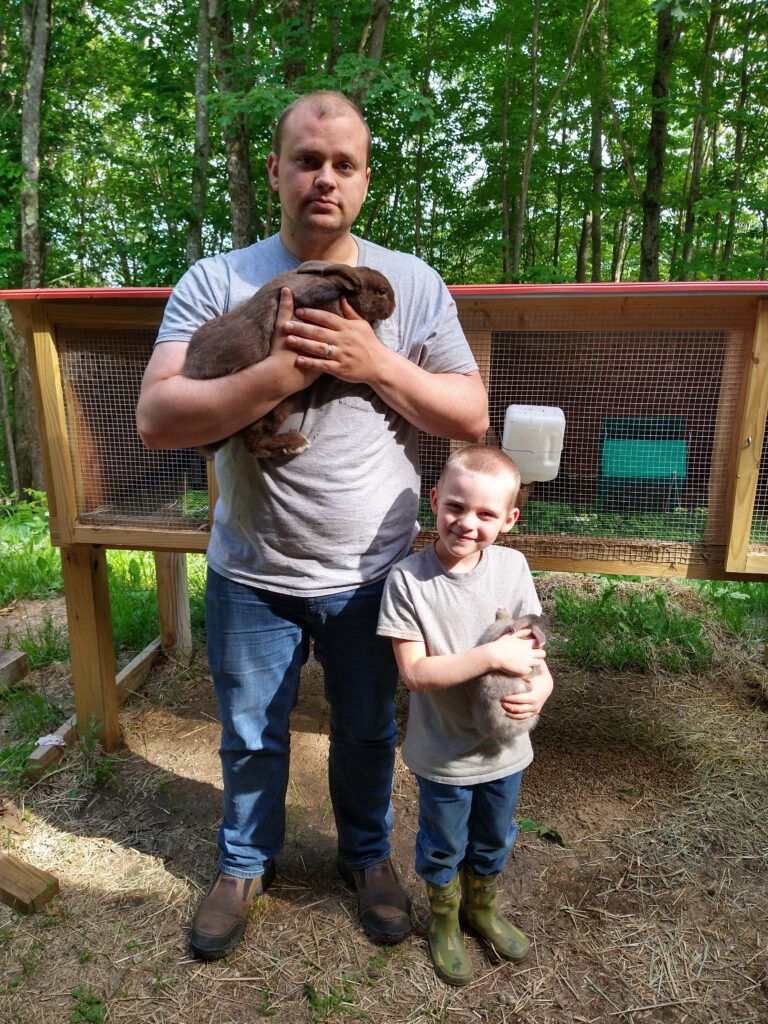
Are Meat Rabbits Easy to Raise and Care For?
Low Maintenance Animals
Rabbits are quiet, clean, and don’t require constant attention. With a consistent routine of feeding, watering, and occasional cleaning, they thrive with minimal fuss.
Simple Diet
They eat mostly hay, pellets, fresh greens, and clean water. You can also supplement with garden scraps and forage for things like clover.
Small Space Requirements
Rabbits don’t need a lot of room. Whether you’re using cages, hutches, or colony setups, they adapt well to small backyards or even urban homesteads.
Easy Clean-Up
Rabbit manure is “cold,” meaning it doesn’t need to be composted before being added to the garden. My rabbits live in hutches with wire flooring. This makes cleaning their enclosures super simple and keeps things fresh and sanitary. Here is a video I did showing you how I collect my rabbit and chicken manure for the garden. You will also be able to better see my meat rabbit set up.
Few Health Issues
With proper care, rabbits are generally healthy animals. Keeping their environment clean and dry, giving them good food, and watching for signs of illness (like runny noses or diarrhea) goes a long way.
Straightforward Breeding
Rabbits breed easily and frequently. Most meat breeds are reliable mothers, and you’ll get the hang of the breeding and weaning process quickly. Kits grow fast and are ready for processing in as little as 12 weeks.
Beginner-Friendly
Even if you’ve never raised livestock before, rabbits are a great place to start. They’re manageable, cost-effective, and the learning curve is gentle compared to animals like chickens or goats. I know chickens are the gateway animal to homesteading or farming, but I actually think rabbits would be a better choice to start raising first.
But I understand that most people may have a difficult time getting past the cuteness factor. I had to get over that myself when I first started raising them!
Meat Rabbits vs Chickens
Can Meat Rabbits and Chickens Live Together?
While it might seem convenient to house rabbits and chickens together, it’s generally not recommended. Rabbits and chickens have very different needs when it comes to living spaces, diets, and health care.
Reasons to Keep Them Separate:
- Stress: Chickens are loud, messy, and peck at things. Rabbits are quiet and easily stressed.
- Sanitation: Chickens produce a lot of droppings that can quickly soil a rabbit’s living area and lead to health issues.
- Injury Risk: Chickens might peck at rabbits, and rabbits can scratch or bite if they feel threatened.
- Different Diets: Chickens and rabbits have very different nutritional needs.
Bottom line:
For the health and happiness of both animals, it’s best to house rabbits and chickens separately.
Can Meat Rabbits Be Free-Range?
Meat rabbits can enjoy supervised outdoor time, but they are not true free-range animals like chickens. They need protection from predators, extreme weather, and getting lost or injured.
Safer alternatives to free-ranging rabbits:
- Rabbit tractors: Portable pens that allow rabbits to graze safely on grass while being fully enclosed.
- Secure outdoor pens: Sturdy fencing with a roof (and buried wire if on the ground) keeps them safe while letting them enjoy foraging.
Important:
Never leave rabbits completely free without secure fencing. They dig, squeeze through small spaces, and are easy targets for predators.
Why Rabbits Are Easier Than Other Livestock
Rabbits are one of the easiest and most efficient animals to raise for meat — especially for small homesteads!
Here’s why rabbits are easier:
- Space-saving: You don’t need large pastures or big barns.
- Quiet: No crowing or loud noises — great for suburban or backyard homesteading.
- Low feed costs: They thrive on simple pellets, hay, and garden scraps.
- Fast reproduction: A single doe can produce dozens of pounds of meat per year.
- Minimal smell: With regular cleaning, rabbits are much less smelly than other livestock.
- Easy to process: Butchering rabbits is quicker and requires less equipment compared to chickens or larger livestock.
In short:
If you’re looking for a small, quiet, efficient meat source for your family, rabbits are one of the best choices you can make!
Meat Rabbit Terminology
Basic Terms
- Doe: Adult female rabbit
- Buck: Adult male rabbit
- Kit: Baby rabbit
- Kindling: The act of a doe giving birth
- Litter: A group of kits born at the same time
Breeding Terms
- Breed Back: Rebreeding a doe shortly after kindling (usually 0–3 weeks postpartum). I don’t practice this in my Rabbitry.
- Fall Off: When the buck successfully mates with a doe, he usually stiffens and falls backward or sideways — this is a good sign!
- Linebreeding: Breeding closely related rabbits (like father to daughter) to preserve traits
- Hybrid Vigor: The improved health and productivity of crossbred rabbits versus purebreds
Growth & Meat Terms
- Grow-Outs: Young rabbits being raised for meat, usually between 4–12 weeks old
- Fryer: A rabbit processed at 8–12 weeks old, weighing 4–5 lbs (ideal meat rabbit age)
- Roaster: An older rabbit, typically processed at 5–8 months old (heavier meat, tougher texture)
- Culling: Removing a rabbit from the breeding program due to poor health, productivity, or temperament — this could mean rehoming, harvesting for meat, or euthanizing humanely
Housing & Health
- Colony: A group-housing system where rabbits live together in a large space or pen
- Trio: A common breeding setup — 1 buck and 2 does
- Nest Box: A box placed in the doe’s cage before kindling, filled with straw/hay for nesting
- GI Stasis: A dangerous condition where the rabbit’s digestive system slows or stops — often caused by diet or stress
Feeding & Manure
- Pellets: Commercial rabbit food made from compressed alfalfa, grains, and vitamins
- Cold Manure: Rabbit manure that doesn’t need composting before use — safe to apply directly to gardens!
Where can I buy Meat Rabbits?
You can buy meat rabbits from a few different sources depending on your location and preferences. Here’s a breakdown of the best places to find quality meat rabbits:
1. Local Breeders
This is often the best way to start — you can meet the breeder, see the rabbits’ living conditions, and ask questions.
- Search online for local rabbit breeders or meat rabbit farms.
- Use a local Facebook group, there are many rabbit pages you can follow as well.
- Try Craigslist under the “Farm & Garden” section (look for breeds like New Zealand, Californian, or Silver Fox). Back when I first started, I found a local Silver Fox breeder through Craigslist.
Always ask about the rabbit’s age, breed, health history, and if they’ve been used for breeding or meat production. You can also request a proven Doe to help get things rolling faster and make things easier for yourself if you are just getting started. Or, like I did, you can get 8 week old babies and raise them up to breeding age. (Don’t worry, we will go over all that information).
2. Homesteading Events or Livestock Auctions
Check out local:
- Homesteading fairs
- 4-H or FFA events
- Small livestock auctions
These are great places to network with experienced breeders.
3. Online Rabbit Registries
Websites like:
These are helpful for finding reputable breeders near you.
Top Meat Rabbit Breeds
| Breed | Weight | Growth Rate | Temperament | Other Notes |
|---|---|---|---|---|
| New Zealand | 9–12 lbs | Fast | Docile | Most popular; large litters; great feed-to-meat ratio |
| Californian | 8–10.5 lbs | Fast | Friendly | Often used for commercial meat production |
| Silver Fox | 9–12 lbs | Moderate | Gentle | Dual-purpose breed; known for soft, black fur |
| American Chinchilla | 9–12 lbs | Moderate | Calm | Heritage breed with excellent meat-to-bone ratio |
| Champagne d’Argent | 9–12 lbs | Moderate | Quiet | Stunning silver coat, efficient meat breed |
| Satin | 8.5–11 lbs | Moderate | Easygoing | Shiny coat; good mothering instincts |
| Palomino | 8–10 lbs | Moderate | Docile | Steady growers with good meat quality |
| Flemish Giant | 14–20+ lbs | Slow | Calm | Huge size, but less efficient due to slower growth & feed needs |
Tips for Choosing the Right Breed:
- If you’re new to meat rabbits, go with New Zealands or Californians — they’re beginner-friendly and prolific.
- Want dual-purpose (meat + fur)? Try Silver Fox or Champagne d’Argent.
- Interested in a heritage breed? Go with American Chinchilla or Palomino.
- Need a breed with calm temperament for families or 4-H? Silver Fox or Satin are great picks.
Everything You Need to Get Started
In the video below I go into detail of what you need to get started raising meat rabbits. I explained why you need each item and where you can get everything.
Find a list of my top recommended products that I use myself here.
What do Meat Rabbits Eat?
1. Pellets
High-quality commercial rabbit pellets are usually the main source of nutrition. Look for 16–18% protein for meat rabbits and breeders. I started with the Producer Pride rabbit pellets, but I have since switched to picking up Top Hutch 18 and Blue Seal carries it.
2. Hay
Hay is critical for gut health and preventing GI stasis. Throughout the winter I provide Timothy hay. When Summer rolls around, I switch to giving them more fresh greens from the garden and foraging.
- Timothy or orchard grass hay for adults
- Alfalfa hay they say is good for growing kits and pregnant/nursing does (high in protein & calcium) but I only use Timothy hay and it has always worked out well for all my rabbits.
3. Fresh Greens
- Romaine, kale, parsley
- Dandelion greens, clover
- Carrot tops, beet greens
- Strawberry Tops are a favorite!
Introduce slowly and avoid overfeeding, especially high-water foods like lettuce or fruit.
6. Clean Water
Fresh, clean water is a must — always available, changed daily. Use bottles or crock-style bowls depending on your setup.
Feed Tips for Meat Rabbits:
- Grow-outs (fryers) need more protein — don’t skimp on pellets!
- Breeding does can be given alfalfa for extra calcium.
- Bucks do well on a steady, moderate diet. If they eat two much, they can become heavy and unproductive with breeding.
How to Slowly Introduce New Foods to Rabbits
Whether you’re:
- Switching pellet brands
- Starting grow-out kits on solid food
- Adding fresh greens to the diet
1. Switching Pellet Brands
Changing from one pellet to another? Here’s a 7-day transition plan:
| Day | Old Feed | New Feed |
|---|---|---|
| 1–2 | 75% | 25% |
| 3–4 | 50% | 50% |
| 5–6 | 25% | 75% |
| 7+ | 0% | 100% |
Watch for soft stools, reduced appetite, or lethargy during the switch.
2. Introducing Fresh Foods (Greens, Forage, Veggies)
Start with one type at a time, in very small amounts:
- Begin with a thumb-sized piece per rabbit
- Observe for 24 hours: is stool still firm? Appetite normal?
- If all is well, increase slightly every few days
- Wait 4–5 days before introducing the next new item
3. Introducing Solid Food to Kits
Kits begin nibbling hay and pellets around 2–3 weeks old while still nursing. By 4 weeks, they’ll start to eat more. You really do not need to take extra steps to introduce the kits to solid food. The Does food will be in there and the kits will nibble on whatever mom eats a little at a time.
- Offer unlimited hay
- Pellets (16–18% protein)
- Avoid fresh greens until 8–10 weeks old — young digestive systems are delicate
When to Breed Meat Rabbits
Knowing the right time to breed your meat rabbits is important for healthy, productive Does!
1. Age & Weight Guidelines
Does (females)
- Age: 5–6 months old
- Weight: At least 80% of her adult weight
- Example: A New Zealand doe should be about 8–9 lbs before breeding.
Bucks (males)
- Age: 6–8 months old
- Should be actively mounting and showing breeding behavior.
Tip: Never breed based only on age. Breed based on weight and maturity. This is something I myself was mistaken by at the beginning.
2. Seasonal Considerations
- Rabbit breed best in cooler weather (spring/fall)
- In hot summers, bucks can go temporarily sterile above 85°F
- Provide shade and plenty of water during the summer months. I like to give my rabbits ice cubes!
Signs Your Doe is Ready to Breed:
- Restless behavior
- Lifting her hind end when touched
- Red, swollen vulva
- Digging or nesting behaviors (sometimes false pregnancy)
How to Breed Meat Rabbits
Breeding meat rabbits is simple once you understand rabbit behavior and timing. Here’s how to do it safely and successfully:
1. Check That Both Rabbits Are Ready
- Doe: At least 5–6 months old and 80% of her adult weight
- Buck: At least 6 months and showing active mating behavior
- Doe’s vulva should be swollen and reddish/purple — a sign of heat
2. Always Take the Doe to the Buck’s Cage
- Does are territorial and may become aggressive if thier space is intruded by the buck.
- Taking the doe to the buck also reduces distractions and increases mating success.
- They can also be bred in a new space that they do not live in. For example, sometimes I breed my rabbits in a small DIY PVC chicken wire net. This method works well too.
3. Watch for Mating Behavior
- The buck will chase, sniff, and attempt to mount the doe
- Successful mating ends with the buck falling off and grunting or stiffening up
- This may happen multiple times — 2–3 successful fall offs are ideal
- Do not be surprised if you see fur pulled in the hutch while breeding. This is normal for the Buck to pull out fur from the back of the Does neck while breeding.
- Supervise the rabbits the entire time. Sometimes Does can get aggressive toward the Buck.
4. What If She Refuses?
- If she kicks, or attacks the buck, remove her.
- Try again later the same day or the next morning, in less than 24 hours since the first exposer to the Buck.
- Some does need a few tries or a new buck to be cooperative.
- If she refuses the buck, give her a break and try again later that day or the next morning. I have noticed often if a Doe is being stubborn or unwilling to breed, she usually will breed if you are consistent.
5. Mark the Date!
- Gestation lasts 28–31 days
- Add her due date to your calendar or breeding log (I created a rabbit breeding log that I use myself. It’s free to download.)
- On the breeding log there is a spot to write down all the important dates.
Dates to Keep Track Of
Keeping accurate records is essential for running an efficient, healthy rabbitry — especially when raising rabbits for meat. This Rabbit Breeding Log helps you monitor each step from breeding to butcher day. Let’s break down each column and why they are important.
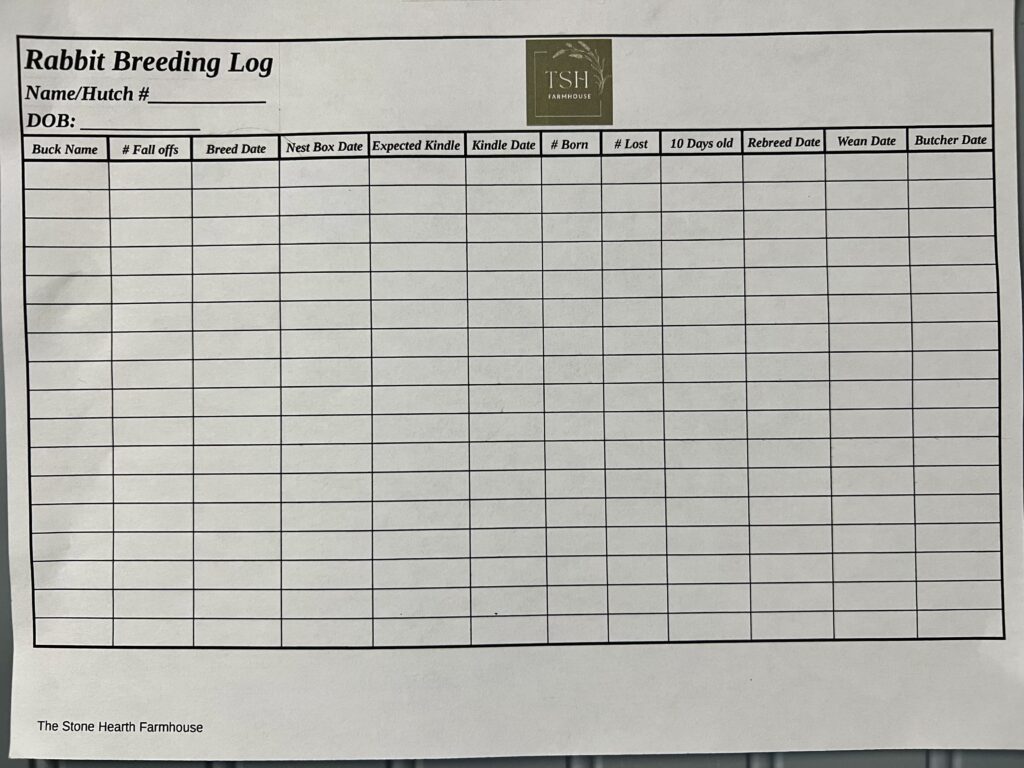
Name/Hutch # and DOB
- Keeps track of individual does, their housing, and age. Knowing a doe’s age is helpful for timing her first breeding and monitoring productivity over time.
Buck Name
- Tracks which buck was used for each litter — important for managing genetics, and evaluating which bucks produce the best offspring. This is for if you have more than one Buck.
# Fall Offs
- “Fall offs” are the number of times the buck successfully bred the doe. More than one is usually ideal. Helps determine the likelihood of the Doe becoming pregnant.
Breed Date
- The day the doe was bred. All other dates (nest box, kindling, etc.) are calculated based on this one.
Nest Box Date
- Usually set around Day 25 post-breeding, this is when you add the nest box so the doe can prepare. Too early = she’ll soil it. Too late = she may give birth on the wire.
Expected Kindle
- Rabbits have a gestation of 28–31 days. This date helps you know when to keep a close eye on her behavior and nesting.
Kindle Date
- The actual birth date. You’ll count from here to weaning, rebreeding, and butchering. Also useful for checking if the doe consistently kindles on time.
# Born
- Tracks litter size. Over time, you’ll learn each doe’s average and which ones produce large, healthy litters.
# Lost
- Helps monitor losses from stillbirth, cold kits, or weak newborns. If a doe consistently loses kits, you may decide to cull or replace her.
10 Days Old
- This is when kits should open their eyes. It is important to make sure the eyes are open and that no crusties have developed to keep their eyes closed. If you skip this step, there is a chance one could become blind or infected. I use a baby wipe and gently wipe the eyes clean until they open.
Re-breed Date
- Depending on your schedule this date keeps your breeding calendar on track. It ensures consistent meat production without over breeding.
Wean Date
- Most growers wean between 4–6 weeks old. Knowing when to separate kits helps avoid fighting, prevent re-breeding from kits to moms, and manage feed more efficiently.
Butcher Date
- The final step for meat production. Most fryers are harvested between 8–12 weeks old, when they reach about 4–5 lbs. Keeping this date organized helps you plan ahead and be prepared.
I hope my breeding log keeps your rabbitry organized, efficient, and productive.
Pregnancy Care & Feed Amounts
Once your doe has been successfully bred, it’s time to shift her care slightly to support a healthy pregnancy and litter. The gestation period for rabbits is about 28–31 days, with most kindling on day 30 or 31. Here’s how to care for her during that time.
General Pregnancy Care
- Keep her stress-free: Avoid unnecessary handling, loud noises.
- No cage changes after day 20: If you plan to move her to a different hutch or breeding pen, do it early in the pregnancy.
Feed Amounts for a Pregnant Doe
During pregnancy, your doe’s nutritional needs increase—especially in the last week.
Weeks 1–2:
Standard adult ration:
- 1/4 to 1/2 cup of high-quality pellets daily
- Unlimited grass hay (timothy, orchard, or meadow)
- Fresh water available at all times
Optional Supplements
These additions can support milk production and overall health:
- Alfalfa hay (in moderation): High in calcium and protein — offer just a handful daily during the last week.
- Herbs: Nettle, raspberry leaf, or chamomile can support relaxation and milk flow (offered dried or fresh).
What to Watch For
- Refusing food or acting restless may be a sign she’s close to kindling.
- She will start pulling fur by kindling day.
- Avoid checking the nest constantly—quick, gentle checks are fine.
With consistent feed, a calm environment, and a prepared nest, your doe will be well on her way to delivering a healthy litter.
How to Prepare a Nest Box
When your doe is about 25 days along in her pregnancy, it’s time to prepare her nest box. A properly set-up box provides warmth, comfort, and a safe place for her to kindle (give birth). Here’s how to build a cozy, effective nest using aspen shavings on the bottom and hay on top.
Supplies You’ll Need:
- A clean nest box (wood or metal)
- Aspen shavings (avoid pine/cedar)
- Soft grass hay (like timothy or orchard)
Clean the Nest Box
Start with a sanitized, dry nest box to prevent bacteria or mold growth. If you’re reusing one, scrub it well and allow it to air dry fully before filling.
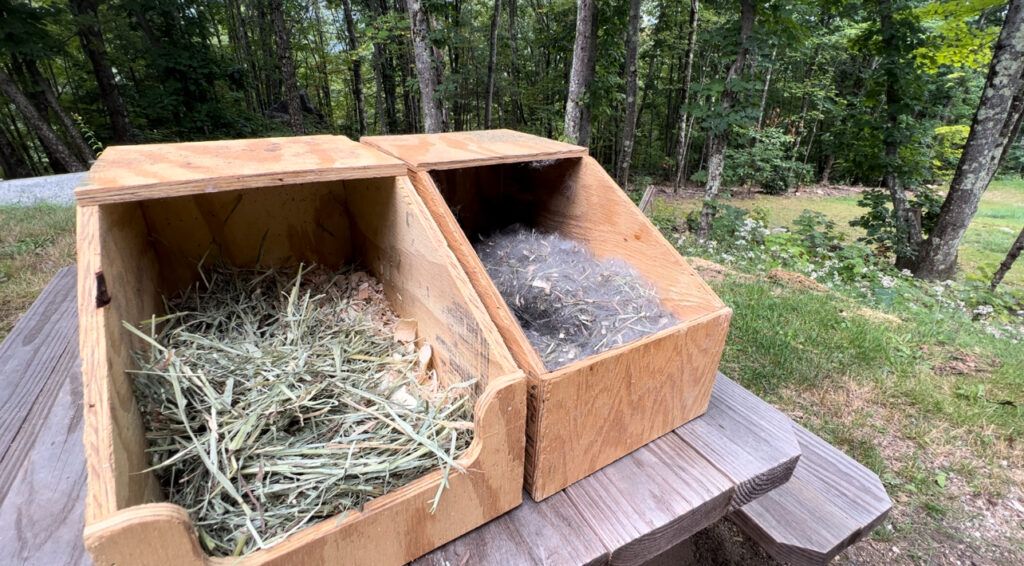
Add a Layer of Aspen Shavings
Line the bottom with 1–2 inches of aspen shavings. Aspen is a safe wood for rabbits and offers:
- Absorbency to soak up any fluids
- A soft, insulating base layer
- Less odor than straw alone
Avoid cedar or pine shavings, which can emit strong aromatic oils that may harm your rabbit’s respiratory system.
Top With Hay
Add a generous mound of hay—about 3–4 inches—on top of the shavings. This is where the doe will dig and burrow to make her nest. Hay holds warmth and gives her a natural, comfy place to kindle.
Tip: If your doe is already nesting or pulling fur, she may start arranging the hay herself. Let her do her thing!
Kindling: What to Expect During Rabbit Birth
Kindling is the term used when a rabbit gives birth. It usually happens around day 30 or 31 of pregnancy, though some does may kindle as early as day 28 or as late as day 33. Being prepared and knowing what to expect helps you support your doe and ensure the best outcome for her and her kits.
- Kits are usually born overnight or early morning
- Check the nest carefully for any stillborn kits or cold ones that need rescuing
- Leave the nest alone for the first day, then do a daily kit count
Signs Kindling is Near
As the big day approaches, you might notice:
- Nesting behavior: The doe starts rearranging hay, digging in the box, and preparing her nest.
- Fur pulling: She’ll pluck fur from her chest and belly to line the nest, keeping the babies warm.
- Decreased appetite or restlessness: Some does get a little antsy or eat less right before giving birth.
The Kindling Process
Kindling usually happens in the early morning hours and is surprisingly quick—often under 30 minutes. The doe will:
- Settle into the nest box.
- Give birth to a litter of anywhere from 4 to 12 kits.
- Clean and nurse them immediately afterward.
What to Watch For Afterward
After kindling:
- Check the nest for any stillborn kits or kits born outside the box. You can gently move cold or misplaced kits back into the nest.
- Count how many were born vs. how many are alive. Record this in your breeding log.
- Avoid disturbing the nest too much. A quick check is okay, but too much interference can stress your doe.
Are the Kits Warm?
A good rule of thumb: warm = alive. Cold kits may still be revived if caught quickly. Warm them gently with your hands or use a rice sock or heating pad before placing them back in the nest.
Record the Kindle Date
Use your rabbit breeding log to mark the kindle date, number born, and number lost. This helps you track litter health, doe performance, and determine the weaning and butchering timeline.
Caring for Rabbit Kits (Baby Bunnies)
Once your doe has kindled, the real work begins—making sure those tiny, fragile kits stay warm, fed, and healthy. The first few days are the most critical. Here’s how to care for your kits from birth to weaning.
Check the Nest
- Gently check the number of kits born and how many are alive.
- Remove any stillborn kits or afterbirth.
- Make sure the babies are warm and covered in fur. If they’re scattered or uncovered, carefully tuck them into the center of the nest.
Record the number born and lost in your breeding log!
Feeding: How Often Do Rabbit Kits Nurse?
Rabbit mothers only nurse once or twice per day, usually in the early morning or late evening. It might seem like she’s ignoring them—but this is totally normal!
Look for these signs that the kits are being fed:
- Rounded bellies
- Pink, warm skin
- Quiet behavior (well-fed kits don’t cry much)
Day 10: Eyes Open
Around day 10, the kits will open their eyes and begin exploring the nest. This is a great time to:
- Do a full nest check
- Remove any soiled hay or wet spots
- Refill the box with fresh hay if needed
Add this checkup to your breeding log under the “10 Days Old” column.
Weeks 2–3: Growing Fast!
By two weeks, kits become much more active. They’ll start hopping in and out of the nest box, nibbling hay, and testing out mom’s food and water. Make sure:
- Water is easily accessible and not too deep
- Pellets and hay are fresh daily
- The cage stays clean and dry
Log Dates to Keep Track Of
Use your rabbit breeding log to track:
- Birth date
- 10-day check
- Weaning date
- Butcher date
With just a little attention each day, your kits will grow strong and healthy. Raising them from birth to weaning is one of the most rewarding parts of homesteading with meat rabbits!
When to Rebreed After the Doe Does Not Kindle
Sometimes a breeding doesn’t take—and that’s okay! It happens to even the most experienced rabbit breeders. If your doe reaches day 35 with no signs of kindling, she likely did not conceive. The good news? You can try again soon.
Confirm She Didn’t Kindle
Before rebreeding, check for:
- No signs of kits or fur pulling
- No changes in appetite or behavior
- No visible abdominal swelling by day 28–30
If she hasn’t kindled by day 35, she’s likely not pregnant.
When to Rebreed
You can rebreed your doe right away—within a day or two after confirming she didn’t kindle.
Some breeders give her a 3–5 day rest period to reset her cycle, especially if:
- She seems stressed or aggressive toward the buck
- She’s underweight or acting “off”
- Weather or heat could affect fertility
Tips for a Successful Second Breeding
- Try a different buck (in case of low fertility or compatibility issues)
- Always breed in the buck’s cage to avoid territorial behavior
- Look for multiple fall-offs during breeding (3 is ideal)
Keep Records in Your Breeding Log
On your rabbit breeding chart, record:
- The date of the original (missed) breeding
- The rebreed date
- Any notes about behavior or possible causes for the missed litter
Tracking patterns will help you improve breeding success over time!
When to Wean Meat Rabbits
Kits are ready to wean between 6–8 weeks. You can begin separating them gradually from the mother, especially if she seems annoyed or they’re crowding her space.
Bucks and does should be separated by 8 weeks to avoid early breeding behaviors.
How to Sex and Separate a Litter
At 6–8 weeks old, your rabbit kits are ready to wean and move into grow-out pens. But before you group them together, it’s crucial to sex them (determine if they’re male or female) and separate them properly to prevent early, accidental breeding.
How to Sex a Rabbit Kit
Sexing young rabbits can feel intimidating at first, but with practice, it gets easier. Here’s a simple guide:
- Hold the kit safely:
Place the rabbit on its back in your lap, supporting its head and spine. Some people gently cradle them like a baby or rest them against their body for better control. - Locate the genital area:
Gently part the fur between the rabbit’s back legs, right in front of the anus. - Apply gentle pressure:
Using your thumb and forefinger, lightly press on either side of the vent to expose the genital opening. - Identify the sex:
- Buck (male): A small, round protrusion (like a tiny tube) will pop out. It may stick up slightly.
- Doe (female): A slit or line-shaped opening will appear, closer to the body.
How to Separate After Weaning
Once you’ve sexed the litter:
- Group by gender: Bucks (males) in one pen, does (females) in another.
- Timing: Separate bucks and does by 8 weeks at the latest.
- Monitor bucks: Bucks may start mounting behavior as early as 10 weeks. Separate aggressive ones if needed.
Weaning and Separation Timeline at a Glance
| Age | Action |
|---|---|
| 6 weeks | Start offering solid food and hay |
| 6–8 weeks | Begin weaning process |
| 8 weeks | Fully separated by sex |
| 10–12 weeks | Monitor for fighting among bucks |
Separating your litter correctly at weaning ensures healthy growth, prevents unwanted pregnancies, and sets your grow-outs up for success!
Raising Grow-Outs: Care After Weaning
After your rabbit kits are weaned at around 6–8 weeks, they enter the grow-out stage — the period between weaning and butchering (usually around 8–12 weeks of age, depending on your breed and target weight). During this time, good care and consistent feeding will lead to healthier rabbits and better meat quality.
Housing for Grow-Out Meat Rabbits: Grow-Out Hutches and Rabbit Tractors
Once your rabbit kits are weaned (typically around 6–8 weeks of age), they need their own space to grow out until they reach butcher weight. Proper housing during this stage is critical to ensure they stay healthy, grow efficiently, and avoid injuries or stress.
How I House My Grow-Out Rabbits
On my homestead, I house my grow-outs in two different ways:
- In a grow-out hutch
- In rabbit tractors on pasture
The main way I house them is in a grow-out hutch. This hutch is separated into two large sections. I separate the weaned rabbits by male and female — one side of the hutch is for the males, and the other side is for the females.
This helps reduce fighting and prevents early, accidental breeding as the rabbits mature.
Separating by sex after weaning is an important management step when raising meat rabbits. It keeps the rabbits safer, reduces injuries, and helps ensure optimal growth without the stress that can come from overcrowding or aggressive behavior.
What Is a Grow-Out Hutch?
A grow-out hutch is a larger cage or pen designed to house multiple weaned rabbits until processing age (usually around 10–12 weeks).
Key Features of a Good Grow-Out Hutch:
- Wire Flooring: Keeps the rabbits cleaner and reduces disease, but provide solid resting boards to prevent sore hocks.
- Shelter: Protection from rain, sun, and predators.
- Ventilation: Good airflow is crucial, especially in warm weather.
Grouping rabbits by gender after weaning (like I do) greatly reduces the risk of fighting and unwanted pregnancies.
What Is a Rabbit Tractor?
A rabbit tractor is a movable, bottomless pen that lets rabbits forage on fresh grass while staying protected. Think of it like a chicken tractor—but for rabbits!
Benefits of Rabbit Tractors:
- Access to Fresh Forage: Rabbits get natural greens, which supplement their diet and enrich their meat flavor.
- Manure Fertilization: Rabbits fertilize your pasture as you move the tractor daily.
- Cost Savings: Reduces pellet feed costs.
Feeding for Fast Growth
Your grow-outs need more calories and protein than adult rabbits. Here’s what to feed:
- Pellets: Offer unlimited meat rabbit grower pellets (16–18% protein is ideal).
- Hay: Keep fresh hay available, especially timothy or orchard grass.
- Water: Clean, fresh water is essential for proper digestion and growth.
Monitoring Growth
Check weight weekly to track progress. Most meat rabbits reach butcher weight by 10–12 weeks, depending on the breed.
Watch for Health Issues
Common issues in grow-outs include:
- Diarrhea: Often caused by sudden feed changes or dirty conditions.
- Respiratory problems: Ensure good ventilation and low ammonia levels.
- Injuries or aggression: Give enough space and hideouts in colony settings.
With proper feed, clean housing, and space to grow, your young rabbits will thrive and give you a productive, healthy harvest.
When to Rebreed the Doe
Timing your re breeding schedule is important to keeping your Does healthy and maintaining a steady supply of meat rabbits. How often you re breed can depend on the season and your doe’s overall condition.
Spring and Fall Breeding
During the cooler, more moderate seasons of spring and fall, I rebreed my does when their kits turn 6 weeks old.
- At 6 weeks: Rebreed the doe.
- At 8 weeks: Wean the kits.
- 2-week rest: The doe then gets two full weeks to rest and regain strength before her next litter arrives.
This cycle keeps production moving efficiently without overly stressing the doe during comfortable weather.
Winter and Summer Re-breeding
During the more extreme temperatures of winter and summer, I adjust the schedule to be gentler on the does:
- At 8 weeks: Rebreed the doe.
- Weaning and rest: Wean the kits right after rebreeding, giving the doe extra time to recover and build reserves before kindling.
The slower winter and summer breeding cycle helps protect the does from the added strain of growing kits while battling cold snaps or summer heatwaves.
Why This Matters
- Healthier does: Adjusting the rebreeding schedule prevents burnout and improves litter quality.
- Stronger litters: Kits born during moderate weather are usually healthier and grow faster.
How to Butcher Meat Rabbits
Processing your own meat rabbits at home can feel intimidating at first, but with practice and the right methods, it becomes a quick, humane, and efficient process. Butchering your own rabbits also ensures you know exactly how the animal was raised and handled. Here’s a basic overview.
How to Dispatch a Meat Rabbit
The first step before butchering is dispatching the rabbit quickly and humanely to minimize stress and suffering. There are several common methods:
1. Cervical Dislocation (Neck Breaking)
- Most common small-farm method.
- The goal is to quickly separate the spinal cord at the neck, causing immediate unconsciousness and death.
- You can use your hands (with practice) or a tool like a broomstick method or a rabbit wringer for more control.
Broomstick Method:
- Place a sturdy stick across the rabbit’s neck, just behind the skull.
- Step on both sides of the stick while pulling up firmly on the rabbit’s hind legs.
- This technique severs the spinal cord instantly.
2. Captive Bolt Tool
- A small, hand-held device that delivers a quick, forceful blow to the skull.
- Used more often in larger setups or farms.
- Offers a very fast, humane dispatch but may be less common for small homesteaders.
How to Butcher a Rabbit Step-by-Step
Once the rabbit is dispatched, move swiftly and calmly through the butchering process:
- Hang the rabbit:
Hang the rabbit upside down by the hind legs. You can use a gambrel or hooks. - Bleed out:
Remove the head to allow the blood to drain fully. - Remove the head and feet:
Using a sharp knife or shears, remove the head at the neck and cut off the front feet at the joint. - Skin the rabbit:
- Start by making a slit around each hind leg.
- Peel the skin downward like removing a jacket. It should come off fairly easily if done right after dispatch.
- Gut the rabbit:
- Carefully slit open the belly from the pelvis up to the ribcage.
- Remove all internal organs, being especially careful around the bladder and intestines to avoid contamination.
- Cool the meat:
- Rinse the carcass thoroughly with clean, cold water.
- Chill the meat immediately in an ice bath before refrigerating or freezing.
Basic Supplies You’ll Need:
- Sharp knife
- Gambrel or hooks
- Clean bucket for guts
- Ice chest for cooling meat
- Broomstick or dispatch tool
- Water hose or rinsing station
Final Thoughts on Butchering
Processing your own meat rabbits is a valuable homesteading skill that deepens your connection to your food.
How to Piece Out and Vacuum Seal Rabbit Meat
After butchering and chilling your rabbit, breaking it down into smaller cuts and vacuum sealing it keeps the meat fresher longer and makes meal prep easier. Here’s exactly how to do it and a playlist on my channel. Find the playlist here.
How to Piece Out a Rabbit
Breaking down a rabbit is similar to cutting up a chicken. Follow these simple steps:
- Remove the front legs:
- Pull each front leg away from the chest.
- Slice through the muscle and connective tissue (no bones to cut through).
- Detach the hind legs:
- Pull the leg outward to pop the hip joint.
- Slice through the joint to remove the leg cleanly.
- Separate the saddle (loin):
- Cut across the spine just above the ribs and again just before the pelvis.
- This releases the thick, meaty midsection (the saddle).
- Optional – Split the saddle:
- You can leave the saddle whole or cut it in half for smaller portions.
- Optional – Save ribs and neck:
- The ribcage and neck aren’t as meaty but are excellent for making bone broth.
How to Vacuum Seal Rabbit Meat
Vacuum sealing is the best way to protect your rabbit meat from freezer burn and extend its storage life.
Steps for Vacuum Sealing:
- Pat dry:
- After chilling, pat each cut dry with a paper towel to remove moisture (helps the vacuum sealer work better).
- Portion the meat:
- Decide how much you want per package (single meals, family-sized portions, etc.).
- Pre-freeze soft pieces (optional):
- If the cuts are very soft, place them in the freezer for 1–2 hours first.
- This firms them up and helps prevent juices from getting sucked into the sealer.
- Place in vacuum bags:
- Arrange pieces flat inside the bag. Leave at least 2–3 inches of space at the top for sealing.
- Seal the bags:
- Follow your vacuum sealer’s instructions.
- Double-seal the edge for extra security if your machine has that option.
- Label each bag:
- Write the cut type, date, and weight if needed.
How Long Will Vacuum-Sealed Rabbit Last?
- Frozen vacuum-sealed rabbit meat will stay fresh for up to 18 months without losing flavor or texture.
Bonus Tips for Best Results:
- Freeze packages flat for easier stacking and faster thawing.
- Group similar cuts together (all legs in one package, all saddles in another).
- Save smaller scraps for broth or stew meat to avoid waste.
Bonus
Can Meat Rabbits Survive Winter?
Yes, meat rabbits are very hardy animals and can survive — and even thrive — during the winter months when cared for properly. Their thick fur coats are naturally designed to handle cold temperatures much better than extreme heat. I have a full playlist on my YouTube channel all about raising meat rabbits in the winter. You can find the playlist here.
How Rabbits Handle Cold Weather
- Rabbits tolerate cold far better than they tolerate heat.
- As long as they stay dry, out of the wind, and have enough food, they can easily live outdoors through freezing temperatures.
Winter Care Tips for Meat Rabbits
- Shelter from wind and snow:
Keep cages in a sheltered area like a barn, shed, or cover them with tarps to block direct wind and moisture. - Deep bedding:
Add extra layers of straw or hay inside nest boxes for insulation. - Dry housing:
Wet, cold rabbits are at risk for hypothermia. Make sure cages stay dry and that any roof coverings are waterproof. - Increased feed:
Rabbits burn more calories to stay warm. Offer extra hay and pellets during winter. - Fresh water:
Check water bottles and crocks several times a day to prevent freezing. Heated water bowls or swapping frozen crocks often can help.
Natural Cold Tolerance
Some breeds, like New Zealand Whites, Californians, and Champagne d’Argent, are especially well-suited for winter raising because of their body size and thick coats. Choosing cold-hardy breeds can make winter care even easier.
In short:
Yes — meat rabbits can absolutely survive and do well in winter with just a few adjustments to their care!
Common Health Problems with Meat Rabbits
While meat rabbits are generally hardy animals, they can sometimes face health issues, especially if their environment, diet, or care isn’t ideal. Knowing the signs early can make the difference between a minor issue and a major problem. I will also note that in the years that I have been raising rabbits in hutches, I have never experienced any of my rabbits having these health issues.
1. Snuffles (Pasteurellosis)
- Symptoms: Runny nose, sneezing, matted fur on front paws, labored breathing
- Cause: Bacterial infection (Pasteurella multocida)
- Treatment: Antibiotics prescribed by a vet; improve ventilation and hygiene to prevent it.
2. Coccidiosis
- Symptoms: Diarrhea (sometimes bloody), weight loss, poor coat condition, lethargy
- Cause: Parasite infection, especially in young rabbits
- Treatment: Anticoccidial medications like sulfa drugs; maintaining clean cages is crucial for prevention.
3. Ear Mites
- Symptoms: Excessive ear scratching, crusty scabs inside ears, head shaking
- Cause: Parasites (Psoroptes cuniculi)
- Treatment: Ivermectin or natural oils like olive oil (under vet advice); clean all housing thoroughly.
4. Sore Hocks (Pododermatitis)
- Symptoms: Red, inflamed, or open wounds on the bottoms of feet
- Cause: Wire flooring without resting boards; obesity
- Treatment: Provide solid resting areas in cages; treat wounds with antiseptic and soft bedding.
5. GI Stasis (Gastrointestinal Stasis)
- Symptoms: Lack of appetite, no fecal pellets, bloated belly, lethargy
- Cause: Low fiber diet, stress, dehydration
- Treatment: Immediate vet care; encourage hay intake and hydration. Prevention is key—always provide unlimited grass hay.
6. Mastitis
- Symptoms: Swollen, hot, red mammary glands in nursing does; reluctance to nurse kits
- Cause: Bacterial infection
- Treatment: Antibiotics and careful kit management; good sanitation can prevent most cases.
7. Heat Stress
- Symptoms: Panting, drooling, lethargy, convulsions
- Cause: High temperatures, poor ventilation
- Treatment: Move rabbits to a cooler area immediately; provide frozen water bottles or fans in hot weather.
How to Keep Meat Rabbits Healthy
- Clean Housing: Regularly clean hutches, feeders, and water bottles.
- Proper Diet: Offer a high-fiber diet and avoid sudden food changes.
- Fresh Water: Keep water clean and available at all times.
- Breeding Management: Avoid overbreeding does and provide proper recovery time.
- Regular Checks: Perform weekly health inspections to catch problems early.
Cooking with Rabbit Meat
Rabbit meat is a delicious, lean protein that’s easy to cook once you know a few basics. Rabbit offers a mild flavor similar to chicken but with a slightly richer taste. Here’s how to make the most of it in your kitchen!
What Does Rabbit Taste Like?
Rabbit meat is:
- Mild and slightly sweet
- Lean with a fine texture
- Tender when cooked properly
Because it’s so lean, it benefits from slow, moist cooking methods — but it can also be grilled, fried, or roasted with great results when prepared carefully.
Best Cooking Methods for Rabbit Meat
1. Braising:
- Brown the rabbit pieces first, then simmer them slowly in broth, wine, or sauce until tender.
- Popular for stews, fricassee, and slow-cooked dishes.
2. Roasting:
- Coat in olive oil, herbs, and seasoning.
- Roast whole rabbits or saddle sections at 325–350°F until juices run clear.
- Baste occasionally to keep the meat moist.
3. Grilling:
- Marinate rabbit overnight to keep it juicy.
- Grill smaller pieces like legs or loins over medium heat.
- Watch closely because it cooks quickly.
4. Frying:
- Similar to fried chicken!
- Dip rabbit pieces in seasoned flour or batter and deep fry until golden.
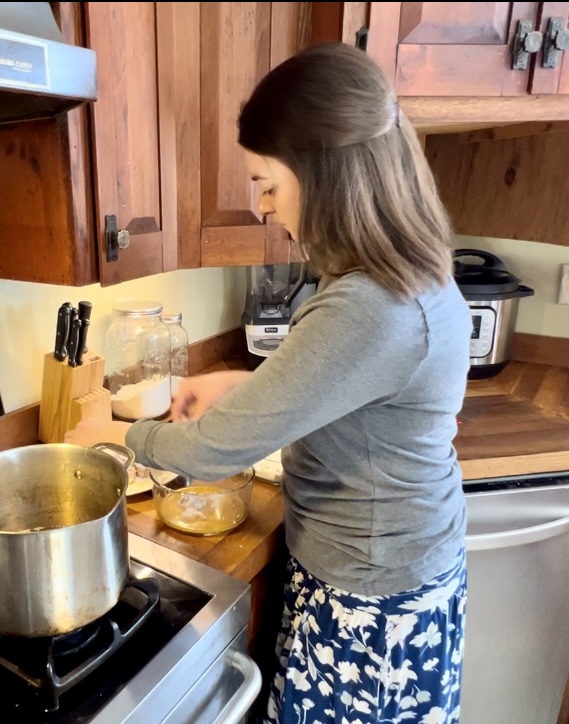
5. Making Broth:
- Use bones, ribcages, and necks to make rich, flavorful rabbit stock for soups and gravies.
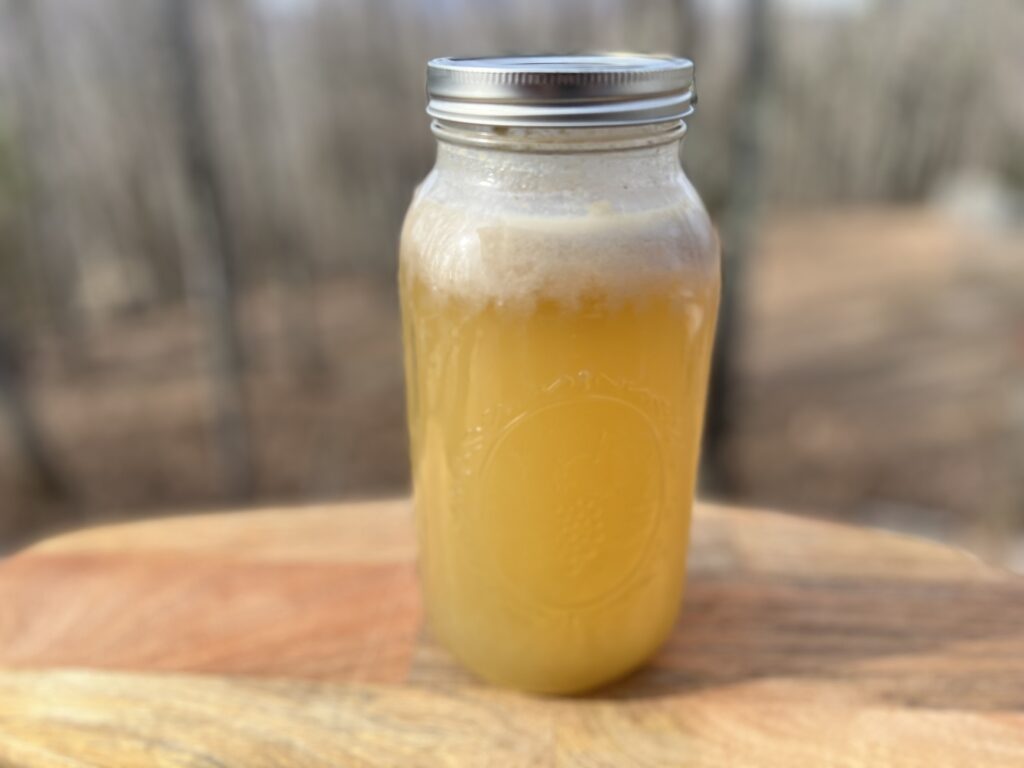
How Long to Cook Rabbit
Rabbit cooks relatively quickly compared to other meats:
- Braising: 1.5–2 hours (until tender)
- Roasting: 45–60 minutes for a whole rabbit at 350°F
- Grilling/Frying: 8–12 minutes per side depending on thickness
Tip:
Always cook rabbit to an internal temperature of 160–165°F for safety.
Rabbit Recipes!
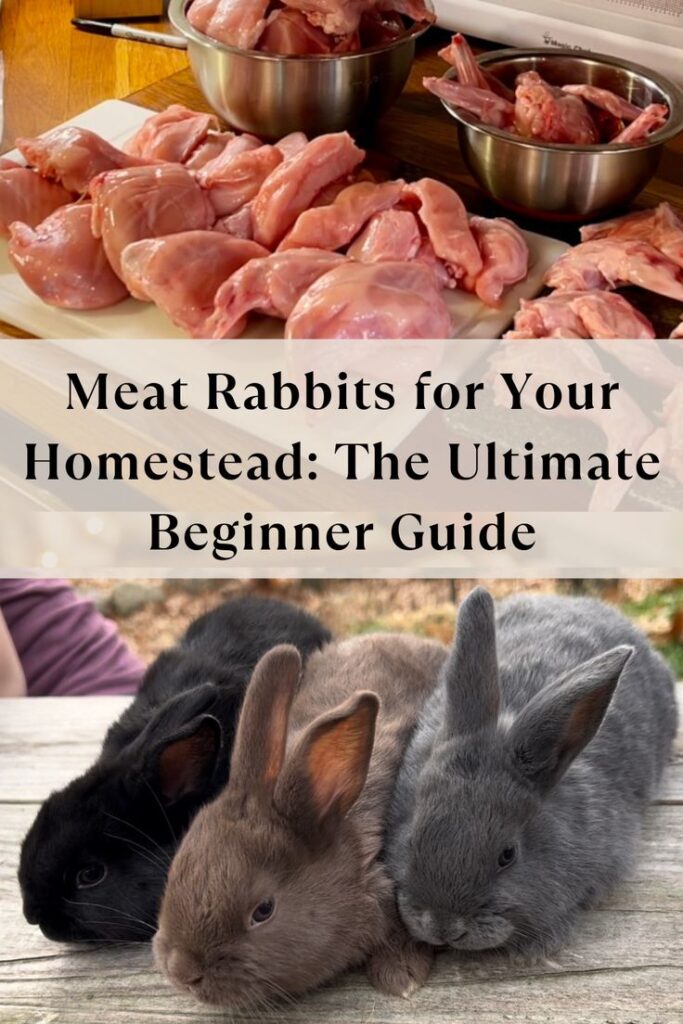
Final Thoughts on Raising Meat Rabbits
Raising meat rabbits is a rewarding way to provide healthy, sustainable food for your family. From breeding and caring for your Does, to butchering, packaging, and cooking —it’s a rewarding process.
Rabbit meat is not only delicious and versatile, but it’s also one of the most efficient meats you can raise on a small scale. With just a little practice, you’ll become confident in raising, processing, and preparing rabbit dishes that nourish and satisfy.
Whether you’re new to meat rabbits or looking to sharpen your skills, I hope this article was a Blessing to you and I wish you the best on your raising meat rabbits journey!
